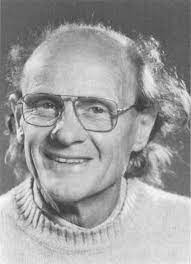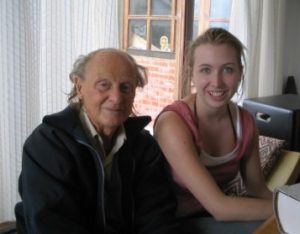
For over twenty years the Lacock Calendar has featured regular events in Andalusia: from 1994 to 2000 in Casares, then from 2001 in Jimena de la Frontera, two of the pueblos blancos in the hills behind Málaga. Among the things that attracted me to this area was the chance to explore its rich natural history and archaeology. Whenever a question stumped all the usual contacts, the reply was also the same: “You’ll have to ask Hamo”.
Hamo turned out to be Hamo Sassoon, an archaeologist who had retired to Andalusia a decade earlier after a career in Africa. He had read geology at Oxford just after the Second World War and had wanted to work in Middle East oil exploration, but had presciently realised that, with an eminent Jewish name, he might have encountered problems. Now, with the candour of retirement, freed from the trammels of academic niceties, he liked to call himself a “speculative archaeologist”
He seemed to be able to identify every plant, animal, mineral, rock or artefact, yet could do so without in the least coming across as a know-all. In fact, quite the opposite: he had a way of explaining things that made it appear that it was your own idea in the first place.
He spoke French, German, Spanish, Portuguese, Arabic, Swahili and Hausa; the only language he admitted being stumped by was that of the elderly goatherd to whom he sometimes gave a lift, catching only “one word in ten”. He also knew four classical languages: Latin, Greek, Hebrew and Arabic, the last of which he studied in Jerusalem while recuparating from injuries suffered when his tank was blown up by Rommel’s army in north Africa, à la English Patient. As the following obituary is not elsewhere on the internet I am pleased to reprint it here, with due thanks to Professor Posnansky.
Obituary by Professor Merrick Posnansky, first published in Azania, volume XL, 2005
Hamo Sassoon was a modest, private, though far from diffident professional, who made his mark in East African archaeology. He was one of the few scholars to have worked in all three east African countries as well as West Africa. His modesty concealed the very major contributions he made to African archaeology in every country where he worked.
Hamo belonged to the generation that came of age during the Second World War. Interrupting his studies at Oxford, he served with distinction in the Tank Regiment part of the Desert Rats that defeated Rommel’s army at El Alamein. After being wounded in action, he recuperated in Lebanon and was conscripted into Intelligence, working in Iraq. As a student of the Middle Eastern Centre of Arabic Studies in Jerusalem he learnt Arabic, a facility that was to help him in his work on the East African coast. After taking a degree in sciences at Oxford, he was appointed an Administrative Officer in the Nigerian Field Service, working largely in north-eastern Nigeria. From 1957-62 he was Deputy Director of Antiquities in Nigeria and in 1963 he became the Conservator of Antiquities for Tanganyika, where he worked until 1968. From Dar-es-Salaam he transferred to Uganda as Inspector of Antiquities, a post he held until 1973, when political conditions precluded further archaeological work in that country. From 1974-76 he was the Curator of the Fort Jesus Museum in Mombasa. From 1976-78 he was the Coastal Archaeologist for Kenya and thereafter organizer of the Mombasa Wreck excavation for the Institute of Nautical Archaeology, for which he wrote in 1978 a very Hamo-esque paper on “Marine thoughts of a land archaeologist derived from the Mombasa Wreck excavation” justifying his work.
Hamo wrote economically and many of his most important written contributions were quite short but have remained extremely valuable. He probably wrote the most informative Annual Reports on Antiquities ever produced in Eastern Africa. I particularly value his 1969 Uganda report on the Monuments Section in which he provided a full listing of all the archaeological and historical monuments of Uganda, complete with publication history. Little did we know that that would be the last major report on Uganda archaeology until the British Institute managed to go back there in 1986. He wrote four very informative reports for the Tanzania Department of Antiquities (1963-66), the last of which included a comprehensive map of the principal sites with descriptive notes and the first good description of the Bweranyange iron figures, which he successfully saved for the national collections in Dar-es-Salaam. His monthly Fort Jesus Newsletter from 1974-75 provided information both on the excavation of the underwater archaeology on the Santo Antonio wreck site, and on developments at the fort and in several important Mombasa town sites. He served a general audience better than any of his contemporaries, writing guides like the ones on Tanzanian Rock paintings, the Kasubi tombs in Uganda and the Kunduchi ruins near Dar-es-Salaam, that have helped countless visitors. He wrote very readable articles for the Kenya National Museum’s support group magazine Kenya Past and Present on “Mysterious Gedi” (1976), “How old is Mombasa?” (1978), the “Santo Antonio Portuguese wreck off Mombasa” (1979), the “Coastal town of Jumba la Mtwana” (1980) and on “Pots and pans from the Portuguese wreck in Mombasa harbour” (1983). Other publishing gems of Hamo’s, often overlooked but indicative of his intellectual range, were his 1967 Antiquities Guide to the Mbozi Meteorite and his excellent 1976 Siwas of Lamu published by the Lamu Museum.
Hamo was very much a renaissance man: he learned to fly when he was thirteen, he loved natural history and classical music, played the recorder and spoke seven different languages other than English and travelled extensively by donkey in the Levant. Perhaps because of his breadth and many moves he never developed any particular theoretical bent nor did he attempt any regional syntheses, but everything he wrote was pertinent and displayed a comprehensive appreciation of the historical context. Hamo should be remembered for three major contributions. Firstly, in Nigeria he revealed the value of looking at the last stages of active iron working as a way of understanding past iron technology. He foreshadowed in his work in north-east Nigeria the later work of such scholars as Nicholas David and Philip de Barros and a whole legion of scholars working in ethnoarchaeology. Secondly, in his work at Engaruka and also at Ngorongoro, where he excavated a series of mounds, he provided some idea of the age range for stone bowls in East Africa and their clear association with other features of first millennium BC pastoralism. No longer were sites like Njoro River Cave in Kenya a startling anomaly. His third major, and probably least recognised, contribution was in the field of coastal archaeology. He arrived on the scene after the heyday of Kirkman and Chittick, who had excavated sites that still had standing walls, like Gedi and Kilwa, sites that had been abandoned in favour of modern settlements. Hamo conducted a rescue excavation of old Mombasa in 1976, revealing its massive walls and a wealth of 13th century material but with up to two centuries of occupation before the stone walls were built. His research, with its usual immaculate description of the finds, enabled historians to know much more about the town that was certainly the best-known on the East African coast at the time of the arrival of the Portuguese.
Though Hamo spent less than four years in Uganda he was particularly effective. He managed to discover, survey and, most importantly, record several 19th century earthwork sites in the Kampala area and tombs in Bunyoro and Toro, and developed several sites, like the Buganda Royal tombs at Kasubi, Baker’s Fort at Patiko and the Nyero rock art site, turning them into accessible monuments with good descriptive sign-boarding and informative guide books.
Though far from being an underwater archaeologist, Hamo was the first terrestrial archaeologist in East Africa to make a major contribution to underwater archaeology, a field hitherto neglected by African archaeologists. He coordinated the excavation from 1978-82, and most importantly the expert conservation and publication of more than 6,000 major finds from the Portuguese frigate Santo Antonio de Tanna , sunk by the defenders of Mombasa in 1697.
Hamo retired from the African archaeological scene far too early in 1982, though not before assisting UNESCO on projects dealing with World Heritage sites in Nigeria and Zimbabwe, writing a particularly readable and informative brief for ICOMOS on the ruins of Great Zimbabwe. He wrote up, and shared with many of his colleagues, his description of the ironwork from Bweranyange, which shortly will receive its long-overdue comprehensive publication. After retiring to Spain he continued with his interest in monuments. His wife Jean wrote that he “gave papers at almost every conference and served on the committee for the Instituto de Estudios Campogibraltareños”. He was honoured by them at a special event in May 2004 and buried, by special permission, at the castle in Jimena de la Frontera that he had been studying for several years. Hamo was blessed by being married to two remarkable women in their own rights: Caroline, who created the wonderful painted recreations for the Igbo Ukwu burials in Nigeria and was herself very knowledgeable on Blue and White East African coastal porcelain and dhow design, and from 1984, Jean Brown, with whom he worked in the Southern Sudan from 1982-84, who had a formidable knowledge of East African archaeology and had gained her doctorate from Edinburgh on traditional iron working in Kenya.
Hamo was ever ready to share his affection for his work with those who worked with him and effectively trained his successors in the several positions he held. He was a relaxed host, loved by those with whom he came into contact and always eager to show visitors around his excavations as well as willing to discuss his insights into African affairs.
Merrick Posnansky
from Azania vol. XL (2005), pp.160-162
 Hamo Sassoon with Theodora van der Beek, at his house in Jimena de la Frontera, April 2004
Hamo Sassoon with Theodora van der Beek, at his house in Jimena de la Frontera, April 2004